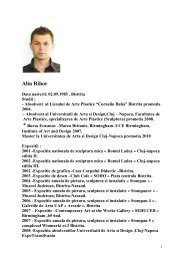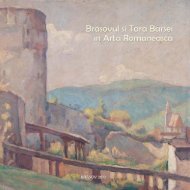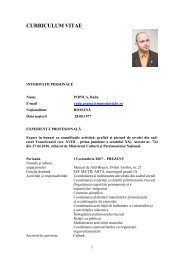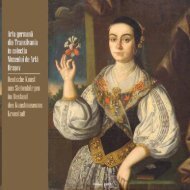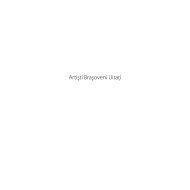Catalog Hans Eder PDF - Muzeul de Arta Brasov
Catalog Hans Eder PDF - Muzeul de Arta Brasov
Catalog Hans Eder PDF - Muzeul de Arta Brasov
Erfolgreiche ePaper selbst erstellen
Machen Sie aus Ihren PDF Publikationen ein blätterbares Flipbook mit unserer einzigartigen Google optimierten e-Paper Software.
întâmplător, în perioada în care <strong>E<strong>de</strong>r</strong><br />
realiza prima sa compoziţie religioasă,<br />
Wilhelm Morgner, reprezentant al expresionismului<br />
renan, picta o Înălţare<br />
a Crucilor 13 . Mulţi dintre expresionişti<br />
au apelat la tematica religioasă, prin<br />
intermediul căreia îşi puteau exprima<br />
într-o manieră indirectă trăirile proprii.<br />
Amintim doar pe Max Beckmann, otto<br />
Dix sau Emil Nol<strong>de</strong>. Asistăm la o convergenţă<br />
spontană, la preluarea unor<br />
teme similare, apte să exprime neliniştile<br />
şi frământările spirituale ale unei<br />
întregi generaţii <strong>de</strong> artişti.<br />
Aşezate într-o continuitate a limbajului<br />
plastic, cele două variante ale Înălţării<br />
Crucilor 14 , pictate <strong>de</strong> <strong>E<strong>de</strong>r</strong> în primii<br />
ani <strong>de</strong> după război, se evi<strong>de</strong>nţiază prin<br />
paroxismul expresiei şi un pregnant patos<br />
tragic. concepţia monumentală, hieratismul<br />
statuar al figurilor, pensulaţia<br />
neliniştită, pasta <strong>de</strong>nsă şi tensiunea cromatică<br />
concură spre a conferi imaginilor<br />
statutul unor veritabile viziuni apocaliptice.<br />
Recursul la lugubru, prezent în<br />
varianta aflată în patrimoniul <strong>Muzeul</strong>ui<br />
Naţional Brukenthal din Sibiu, indică interesul<br />
pentru mo<strong>de</strong>lul oferit <strong>de</strong> pictura<br />
germană din secolele xv-xvi.<br />
treptat, în următoarele variante ale<br />
Răstignirii, expresia se îmblânzeşte.<br />
contribuie la această senzaţie localizarea<br />
Răstignirii în cadrul familiar al spaţiului<br />
transilvan. Martorii săi sunt acum<br />
oamenii simpli din satele transilvaniei.<br />
Dominant <strong>de</strong>vine un sentiment calm<br />
al tragicului, accentul <strong>de</strong>plasându-se<br />
<strong>de</strong> la exaltarea violentă a suferinţei<br />
spre o resemnare tăcută.<br />
Exemplară pentru această evoluţie<br />
este Răstignirea la marginea satului 15 <strong>de</strong><br />
die i<strong>de</strong>enwelt einer „verlorenen Generation”<br />
(Dan Grigorescu). Das metaphysische<br />
Angstgefühl <strong>de</strong>r expressionistischen<br />
Generation war <strong>de</strong>m von<br />
<strong>de</strong>r Mo<strong>de</strong>rne in aller Schärfe wahrgenommenen<br />
unwie<strong>de</strong>rbringlichen verlust<br />
<strong>de</strong>r göttlichen Bezugspunkte verwandt.<br />
Es ist kein zufall, dass zur gleichen<br />
zeit, als <strong>E<strong>de</strong>r</strong> an seinem ersten<br />
religiös geprägten Werk arbeitete, Wilhelm<br />
Morgner, ein vertreter <strong>de</strong>s Rheinischen<br />
Expressionismus, eine Kreuzaufrichtung<br />
13 malte. viele Expressionisten<br />
haben die religiöse thematik aufgegriffen,<br />
durch die sie ihre eigenen<br />
Gefühle auf indirekte Weise ausdrücken<br />
konnten. Es seien hier nur Max<br />
Beckmann, otto Dix o<strong>de</strong>r Emil Nol<strong>de</strong><br />
genannt. Wir wer<strong>de</strong>n zeugen einer<br />
spontanen Konvergenz, <strong>de</strong>s Übernehmens<br />
ähnlicher themen, die sich dazu<br />
eignen, die Unruhe und <strong>de</strong>n spirituellen<br />
Aufruhr einer ganzen Künstlergeneration<br />
auszudrücken.<br />
Betrachtet man sie im Kontext und<br />
bezüglich <strong>de</strong>s künstlerischen Ausdrucks,<br />
zeichnen sich die zwei varianten<br />
<strong>de</strong>r Kreuzaufrichtung 14 , die <strong>E<strong>de</strong>r</strong> in<br />
<strong>de</strong>n ersten Nachkriegsjahren gemalt<br />
hat, durch vollkommenheit <strong>de</strong>s Ausdrucks<br />
und ein prägnantes tragisches<br />
pathos aus. Das monumentale Konzept,<br />
die statuenhafte Erstarrung <strong>de</strong>r<br />
Gestalten, die unruhige pinselführung,<br />
das dicke Auftragen <strong>de</strong>r Farbe, und die<br />
chromatische Spannung verleihen <strong>de</strong>n<br />
Bil<strong>de</strong>rn <strong>de</strong>n Status wahrhaft apokalyptischer<br />
visionen. Der Rückgriff auf das<br />
Düster-Schauerliche in <strong>de</strong>r variante<br />
aus <strong>de</strong>m Besitz <strong>de</strong>s Brukenthal-Museums<br />
in Hermannstadt/ Sibiu, <strong>de</strong>utet<br />
of paint, the chromatic turmoil, all<br />
confer the status of a veritable apocalyptic<br />
vision on the images. the appeal<br />
to the dismal, present in the variant<br />
belonging to the Brukenthal National<br />
Museum, is an indication of the interest<br />
for a mo<strong>de</strong>l which was provi<strong>de</strong>d by<br />
the 15 th -16 th century German painting.<br />
Gradually, in the next variants of the<br />
Crucifixion, the expression becomes<br />
mil<strong>de</strong>r. this sensation is enhanced by<br />
the fact that the Crucifixion is placed in<br />
the familiar background of transylvania.<br />
His witnesses are ordinary people.<br />
the calm feeling of the tragical becomes<br />
dominant and the accent shifts<br />
from the violent exaltation of suffering,<br />
towards a silent submission.<br />
the mo<strong>de</strong>l for this evolution is Crucifixion<br />
Near the Village 15 , belonging<br />
to the National Art Museum of Romania,<br />
painting which heralds the end<br />
of a stylistic stage in <strong>E<strong>de</strong>r</strong>’s religious<br />
pain tings and also the beginning of a<br />
new stage. in this new stage, the artist<br />
gra dually abandons the violent expression<br />
of expressionistic influence in<br />
favour of a stylistic approach marked<br />
by his orientation towards the New<br />
objectivity (Neue Sachlichkeit); however,<br />
at least for a while, the two coexist.<br />
other expressionists down the<br />
same road in the third <strong>de</strong>ca<strong>de</strong> of the<br />
20 th century, otto Dix, Max Beckmann,<br />
and Käthe Kollwitz were won over by<br />
the aesthetics of the New objectivity.<br />
Set against the background of a<br />
magnificent alpine scenery, in the<br />
setting of a transylvanian village, the<br />
composition enhances the contrast<br />
between a <strong>de</strong>ceiving serenity and a



